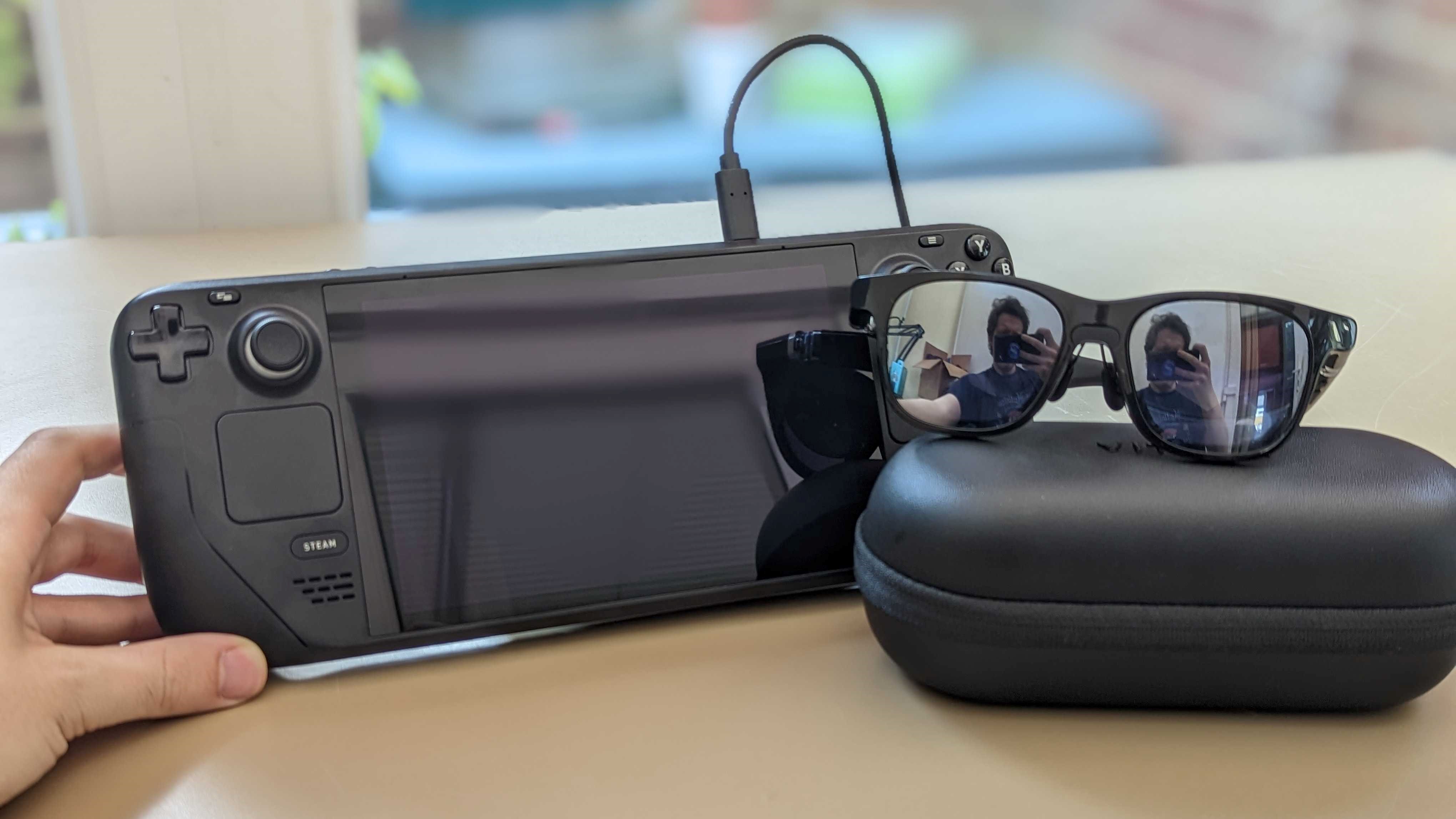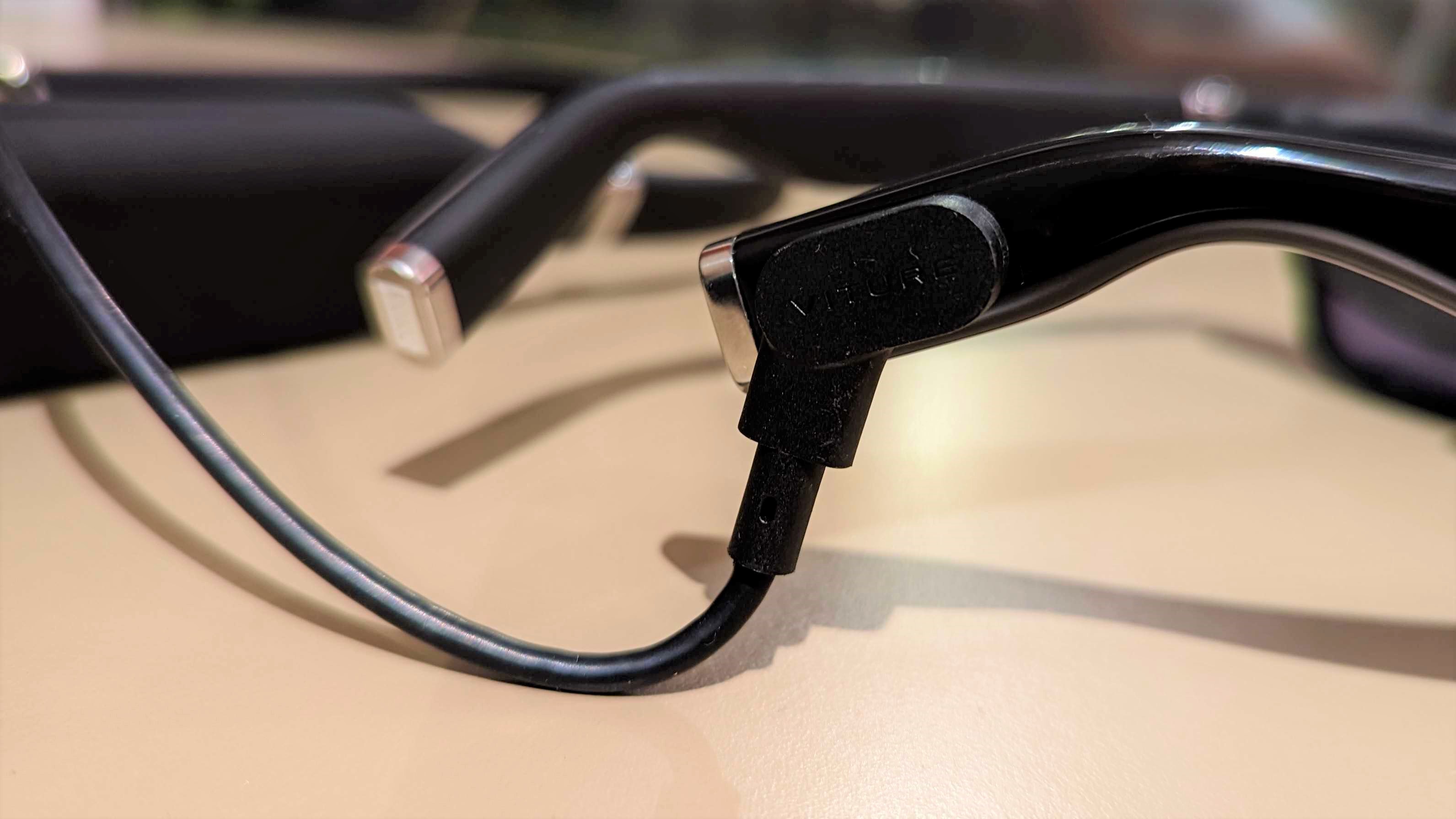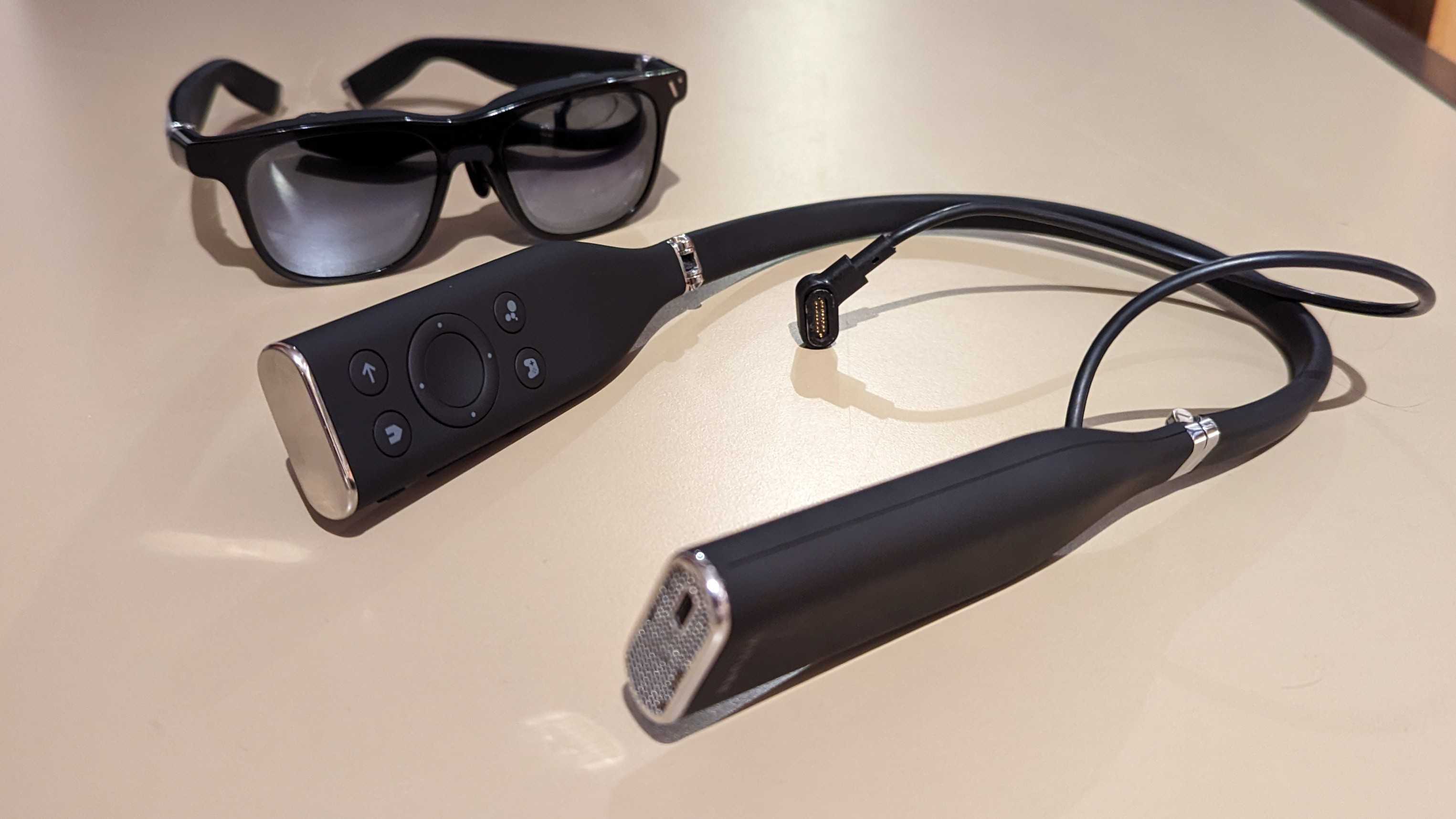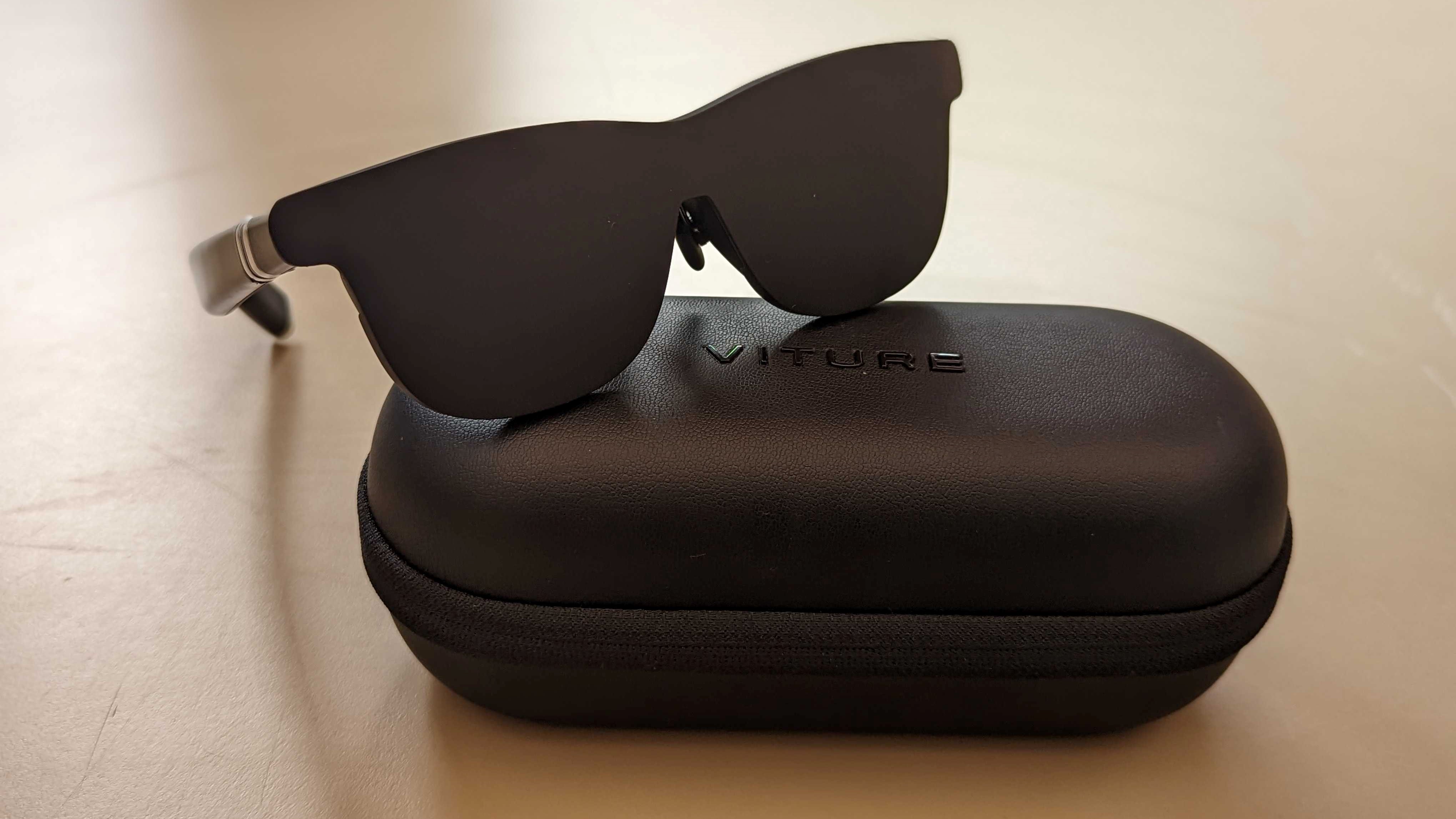VITURE One XR Glasses review
VITURE One XR Glasses: One-minute review
The VITURE One XR Glasses are like a portable projector for your face. Slap them on, connect them to a compatible smartphone, laptop, or games console and their full-HD OLED displays will virtually project a 120-inch screen before your eyes.
We say virtually project as onlookers won’t be able to see the screen floating in mid-air that you can see. Instead, these AR glasses provide you with a private personal home-cinema experience complete with surround sound – and you can take them anywhere you go.
However, while the glasses promise a lot they don’t really deliver thanks to their lacking design. They don’t quite sit right on your face, meaning too much light can be let in and spoil the experience. In addition, the edges of the image can get quite blurry, making playing games and watching shows a bit of a challenge.
If VITURE can release new nose clip options and a better cover that helps block out more light from the wearer’s surroundings then these could be a fairly nifty gadget. Unfortunately, as they are right now the One XR Glasses aren’t a pair of smart specs that we can recommend.
VITURE One XR Glasses: Price and availability
The VITURE One XR Glasses are available to buy in four different packages
The most basic is buying the glasses on their own, which costs $479 (around £425 / AU$720). Taking things up a gear is the Dock Pack, which includes the glasses and a mobile dock so you can use the glasses with your Nintendo Switch and other HDMI-compatible devices; it’s $568 (around £500 / AU$855). Alternatively, you could nab the Cloud Pack for $588 (around £520 / AU$885) and swap the dock for a neckband that allows you to stream TV shows and games to the glasses over Wi-Fi.
Or, if you want it all, you can get the Ultimate pack for $677 (around £599 / AU$1,019).

We were sent the Cloud Pack and definitely think this one is the best value for money of the four options – the dock seems useful but the neckband is what makes the glasses feel like they’re a portable projector rather than just an AR monitor for your phone or Steam Deck.
That said, these prices feel pretty darn high for what you’re getting, but that’s an issue we’ve noticed with AR glasses in general. The tech is a bit too new for it to come at an affordable, mainstream price yet, so prices like $477 are roughly what you can expect to pay right now.
- Value score: 2/5
VITURE One XR Glasses: Design
Whether you pick the black, white, or blue model, you’ll find there are a lot of similarities between the VITURE One XR glasses and other AR specs on the market like the Nreal Air AR glasses.
Just like Nreal’s offering they look like a fairly normal – albeit chunky (coming in at 78g / 0.17lbs) – pair of shades with interchangeable and adjustable nose clips. The wired connection is placed at the end of one of the arms too, though VITURE has opted for a slightly different placement (on the side rather than the tip) and to use a magnetic pogo pin instead of a USB-C port. It works just as well though; the connection is secure and never came loose while we were using the glasses.
The glasses also come with a plastic cover for the lenses to help stop light coming through the lenses, just like the Nreal Airs.
However VITURE doesn’t just copy its rival, and the first improvement it makes is to the glasses’ regular lenses. VITURE’s glasses use mirrored lenses instead of simply dark tinted ones, which better hide the internal screens from onlookers. In addition, it adds controls to the glasses themselves, with a button on the left arm that lets you control volume, brightness, and a few other settings.
You’ll also find dials on the top of each lens that let your correct the image between 0D and -5.0D to help you see what’s being displayed if you’re near-sighted.
Unfortunately, for all the improvements, the VITURE Glasses also take a few steps back.
The biggest problem with the design is that the glasses don’t dominate enough of your vision – there’s a lot of space around the side of them that lets light and distractions get in the way of your immersed experience. On top of that, we noticed that the picture always looked a little blurry, especially at the periphery where the most distractions were.
Part of this is caused by the lenses not being quite large enough, but the nose clips also bear some of the blame. While there are three clips to choose from in the box they aren’t quite malleable enough, so we couldn’t alter their shape at all and make the glasses sit properly.
To get around this we’d love to see VITURE release some better nose clips, and potentially look at a plastic cover that could surround the glasses – turning them from glasses to something more like goggles. When we help the glasses in the right place and cup our hands around the specs to block out more light the issues became much less noticeable.

On top of these issues, the dials for near-sightedness, while a neat concept, fall a little short as they could still keep some players excluded. Nreal included an add-on for its AR glasses that could be outfitted with any kind of prescription lenses, a feature that could have worked just as well for VITURE.
Moving past the glasses, the neckband is generally great. The 170g electronic is comfy to wear and the connector cable is the perfect length – long enough to reach the glasses but not so long that it leaves too much excess lying around.
The only downside is the controller placement. It sits with the buttons facing your chest meaning you can’t actually see what you’re pressing – so you’ll need to memorize the layout before putting the glasses on.
- Design score: 1/5
VITURE One XR Glasses: Performance
To put VITURE’s glasses through their paces we used them to play Stray and Marvel’s Spider-Man: Remastered on the Steam Deck.
Stray is a game chock full of dusky city streets, with levels where the only illumination is from neon lights and bioluminescent matter. Despite being filled with generally darker scenes the VITURE glasses put their 5000:1 contrast ratio to good use and helped keep the game’s objects fairly well defined instead of a mess of indiscernible dark blobs.
Meanwhile, the daytime streets of New York City and Spidey’s cartoonishly bright red, blue and white suit were rendered pretty well too. We would have liked some of the brighter colors to pop more but this full-HD OLED screen with 1800 nits of brightness still made sure that swinging from digital skyscrapers didn’t lose much of the magic.
To help make everything look as great as it can we’d recommend turning the glasses up to high brightness and wearing them in a fairly dark room with the lights off or at least dimmed – the same sort of setup we’d recommend for a projector. Even in this ideal setting, you won’t get an experience that’s on par with one of the best OLED TVs, nor one of the best 4K projectors, but it’ll be about as good as a mid-range projector. For something that you can take with you and wear on your face that’s not half bad.

The image latency seemed fine too, there were no noticeable input delays, so we could still pull off Spidey’s web-slinging combat combos without issue.
But, as we mentioned above because of the specs’ design we did face some issues with the outer edges of the image being blurry. This wasn’t always a problem if the subject was in the center of the screen, but if we needed to read an in-game menu or pay attention to something at the edge we couldn’t tell what was going on. Over time the blurry image also gave us a headache, limiting the length of time we could stay immersed in each session.
Audio-wise these glasses house some pretty solid Harmon speakers that provide spatial audio for whatever you’re playing or watching. However, if you have a pair of great headphones lying around we’d suggest using those instead.
The VITURE One XR’s speakers didn’t have enough oomph to provide the majesty that’s required by some tracks – like the heroic orchestral tracks that play in the background of Marvel’s Spider-Man. This left the audio feeling a little empty at times, something which we easily fixed using a pair of cans.
- Performance score: 2/5
VITURE One XR Glasses: Features
The VITURE One XR glasses are compatible with any device that supports video output through a USB-C port. This means you can hook them up to your Steam Deck, Apple MacBook Pro 13-inch (M2, 2022), iPad Air (2022), and many of the best Windows laptops and Android smartphones, to name just a few devices.
That said, we’d recommend checking your devices are indeed usable with these glasses before you buy. Case in point, despite being Google’s top-of-the-line phone the Google Pixel 6 isn’t compatible as it doesn’t support video output through its USB-C port.
One device they are compatible with is the VITURE neckband, which effectively turns the VITURE One XR Glasses into a portable projector with the Android 11 TV OS. Beyond being able to access apps like Netflix and YouTube, you can access game streaming through Google Stadia, Nvidia GeForce Now, and PlayStation 5 remote play.
And thanks to its Bluetooth connectivity you can hook up your wireless game controller so you can play those streamed games the way you like. What’s more, if you want to download videos or apps to the neckband you can use its 128GB to good effect.

Last but not least is the Mobile Deck, which is compatible with the Nintendo Switch, Nintendo Switch OLED, Steam Deck, and any device that outputs video with an HDMI – which includes some of the best iPhones if you use a Lightning-HDMI adapter.
While the VITURE One XRs don’t come with their own unique features, they more than make up for it with the breadth of compatible devices that you can hook them up to. Plus, the neckband helps make the VITURE glasses feel like an entertainment system in its own right rather than just a portable monitor.
- Features score: 4/5
VITURE One XR Glasses: Battery
The VITURE One XR glasses don’t have a battery, instead using the internal charge of the connected device to power the screen. While this does help to keep the glasses fairly light, it also means that you can expect the Steam Deck’s fairly short battery life to get slashed further – especially if you’re playing a labor-intensive game.
What’s more, because the glasses rely on a wired connection you can’t plug your Steam Deck in to charge while also using the specs. That means while you can get a decent play time out of games like Stray, you’ll need to make sure your Deck is fully charged before jumping into something like Spider-Man Remastered if you want to game for a while.
The problem persists on other devices too, however, the impact isn’t quite as severe as it is on the Steam Deck.
Much like other AR glasses that we’ve tested, we’d love it if the VITURE One XR glasses either had their own internal battery or if there was a way to use the glasses and charge the connected device at the same time.
As for VITURE’s own add-ons, the neckband and mobile dock do each have their own internal batteries. The neckband currently lasts for three and a half hours and charges up to full in about one hour and 20 minutes. VITURE tells us it’s still working on optimizing the battery so we could see these details change. The mobile deck, on the other hand, boasts up to a 12-hour charge, or eight hours if it's connected to a Nintendo Switch.
- Battery score: 3/5
VITURE One XR Glasses Score Card
| Attributes | Notes | Rating |
|---|---|---|
| Design | These sleek, lightweight glasses are comfy to wear and connect to your gadgets easily, but they don't sit right which has a huge impact on the image quality. | 1/5 |
| Performance | VITURE's XR glasses offer a pretty solid image that is utterly ruined by poor design choices that drastically reduce what the specs are capable of. | 2/5 |
| Features | You can uses these glasses with loads of different devices, and the neckband turns that into a private portable projector. | 4/5 |
| Battery | The VITURE glasses will have a big impact on the batter life of devices you plug them into, but its first-party peripheral should last a while. | 3/5 |
| Vaue | AR glasses feel a bit too expensive for wat they offer right now, and that especially true of the VITURE specs based on our experience. | 2/5 |

Should I Buy The VITURE One XR Glasses?
Buy it if…
Don’t buy it if…
Also consider
First reviewed: September 2022
How we test
We pride ourselves on our independence and our rigorous review-testing process, offering up long-term attention to the products we review and making sure our reviews are updated and maintained - regardless of when a device was released, if you can still buy it, it's on our radar.
0 comments:
Post a Comment